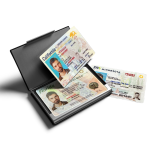Understanding the Purpose of a Real ID Appointment
A Real ID is a federally compliant form of identification required for domestic air travel and access to certain federal facilities starting May 7, 2025. Unlike standard driver’s licenses, Real IDs include enhanced security features and demand stricter documentation to verify identity, residency, and legal status. Attending an in-person appointment is mandatory to complete the application, as it involves physical document verification, biometric data collection, and a state-issued photo. This guide breaks down the entire process so you know exactly what to do before, during, and after your appointment.
Step 1: Preparing for Your Appointment
Preparation is key to a smooth Real ID application. Most delays or rejections stem from missing or incorrect documents, so start by gathering the following:
1. Proof of Identity
You must present one original or certified document that shows your full legal name and date of birth. Common examples include:
- U.S. birth certificate (issued by a state or territory, not a hospital)
- Valid U.S. passport or passport card
- Consular Report of Birth Abroad (FS-240, DS-1350, or FS-545)
- Permanent Resident Card (Green Card)
- Employment Authorization Document (EAD) with photo (I-766)
Note: If your current name differs from what’s on your identity document (e.g., due to marriage, divorce, or court order), you must also provide legal proof of the name change, such as a marriage certificate, divorce decree, or court order.
2. Social Security Number (SSN) Verification
You need to show your full SSN. Acceptable documents include:
- Social Security card (original or copy)
- W-2 form (with full SSN)
- Pay stub with full SSN
- SSA-1099 or non-SSA-1099 (with full SSN)
If you don’t have a Social Security number, check your state’s DMV website for alternative requirements (e.g., for non-immigrants).

3. Two Proofs of State Residency
You must prove you live in the state where you’re applying. Documents must show your full name and current address, and cannot be more than 60 days old (in most states). Examples include:
- Utility bill (electric, water, gas, internet)
- Bank or credit card statement
- Lease or rental agreement
- Vehicle registration or insurance card
- Pay stub with address
P.O. boxes are not accepted; the address must be a physical location.
4. Legal Status Verification (If Applicable)
Non-U.S. citizens must provide documents proving lawful presence, such as:
- Valid foreign passport with a valid U.S. visa and I-94 admission record
- Refugee Travel Document (I-571)
- Certificate of Naturalization (N-550, N-570)
Check your state’s DMV website for specific requirements, as some states may have additional rules.
Pro Tip: Use the DMV’s online document checker tool (if available) to confirm exactly what you need. Each state has slight variations—for example, California requires a primary and secondary residency document, while Texas may accept a voter registration card as proof.

Step 2: Arriving at the DMV
On the day of your appointment:
Arrive Early
Plan to arrive 15–30 minutes before your scheduled time. Traffic, parking, or check-in lines can cause delays, and arriving late may result in rescheduling. Most DMVs allow walk-ins, but appointments prioritize your slot.
Bring All Original Documents
Copies are not accepted for identity or legal status proofs. The DMV will scan or photocopy your documents, but you’ll keep the originals. If a document is in a language other than English, you may need a certified translation.
What to Leave Behind
Avoid bringing unnecessary items. Large bags, weapons, or prohibited items (check your state’s rules) may be confiscated. Also, leave pets at home—most DMVs don’t allow animals unless they’re service animals.
Step 3: The Appointment Process
Once checked in, here’s what happens next:
Document Verification
A DMV clerk will review your documents to ensure they meet federal and state standards. They may ask questions about discrepancies (e.g., a name change or expired passport). If a document is invalid or missing, you’ll be asked to return with the correct items. In some cases, the clerk may make a copy of your documents for their records.
Application Form Submission
You’ll fill out a Real ID application form (available online or at the DMV). This includes personal details like your address, eye color, and height. Double-check for errors—mistakes can delay your ID.
Biometric Data Collection
- Photo: You’ll take a standard ID photo. Rules include no hats, sunglasses (unless medically required), or excessive makeup. Smile naturally, but avoid extreme expressions. If you’re unhappy with the photo, some states allow one retake—ask politely.
- Fingerprints: You’ll provide digital fingerprints (all 10 fingers). This is a quick, inkless process that takes less than a minute. The DMV uses this for background checks and identity verification.
Payment
Fees vary by state, typically ranging from $30 to $50. Payment methods include cash, check, or credit/debit card (some DMVs charge a processing fee for cards). Keep your receipt—it serves as a temporary ID until your Real ID arrives.
Step 4: Post-Appointment Follow-Up
After your appointment:
Receiving Your Real ID
Most states mail the Real ID within 10–15 business days. If you need it faster, check if your state offers expedited processing (fees apply). You’ll receive a temporary paper ID to use until the plastic card arrives.
Tracking Your ID
Many states provide online tracking tools. Visit your state’s DMV website and enter your application number or receipt details to check the status.
What If There’s a Delay?
If your ID doesn’t arrive within 30 days, contact the DMV. Common reasons for delays include incorrect mailing addresses, processing backlogs, or missing documents during the initial appointment.
5 Common Problems and Solutions
Problem 1: Missing a Required Document
Solution: Before leaving home, cross-verify your documents with the state’s checklist. If you realize you’re missing something at the DMV, ask the clerk if you can submit it later (some states allow partial processing). Otherwise, reschedule your appointment and gather the missing item. For example, if you forgot your birth certificate, request a certified copy from your state’s vital records office (fees apply, but it’s faster than waiting for mail).
Problem 2: Long Wait Times Despite an Appointment
Solution: Appointments reduce wait times, but peak hours (mornings, Fridays, or end of the month) can still be busy. Arrive at the DMV’s opening time, check online wait times (if available), or schedule during off-peak days (e.g., Tuesdays or Wednesdays). Some states offer mobile DMV units for rural areas—check if that’s an option.
Problem 3: Name Mismatch on Documents
Solution: Always bring legal proof of name changes (marriage certificate, divorce decree, etc.). If your birth certificate and Social Security card have different names, explain the discrepancy to the clerk. They may require additional forms or notarized statements. For example, if you changed your name via court order, provide the original court document.
Problem 4: Appointment Cancellation or No-Show
Solution: If you can’t attend, cancel or reschedule online at least 24 hours in advance (late cancellations may incur fees). If you miss the appointment, call the DMV immediately—some offices allow same-day rescheduling if there’s availability. Repeated no-shows may require waiting longer to book a new slot.
Problem 5: Unacceptable ID Photo
Solution: Follow photo guidelines strictly: no hats, neutral expression, and avoid clothing that matches the background (usually white or light gray). If you’re unhappy with the result, ask the clerk if a retake is possible. Some states allow one free retake per appointment. If denied, you’ll need to pay a fee to redo the photo in a new appointment.



